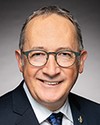The CVMA, through the national examining board, which is an arm's-length organization that oversees the licensing of veterinarians in Canada, has been very active in this regard. We've worked very closely with testing sites at the Western College of Veterinary Medicine, which does all the in-clinic testing for graduates who are from abroad.
From speaking with the college, on paper, it may look at times like there's a backlog, but when there's a call to take the exam, not all candidates reply in the positive. There are systems in place, and they appear to be working well. Often, what's happening is that when there is a call for testing, there are not enough candidates to put the testing on, because it takes a certain group to do it at a time.
We've also started to explore more closely a pathway to limited licensure. We have a consultant working on this at this point in time, whom we've co-funded this year with the registrar group in Canada that oversees licensing in the provinces. That is something we're going to continue to work on. That will be coming forward throughout 2023.
That is something that should, hopefully, allow entry to someone with specific skill sets. For example, if there are cattle practitioners in a different country and they wanted to come to Canada, it should allow us to ask, do they have the skill set to work with cattle, and can we license them here in a limited way? We're not asking them to do something they have not done in 20 years, for example, with cats or horses.
We're exploring those opportunities. I think they show good potential, and we're certainly committed to working in that regard.




